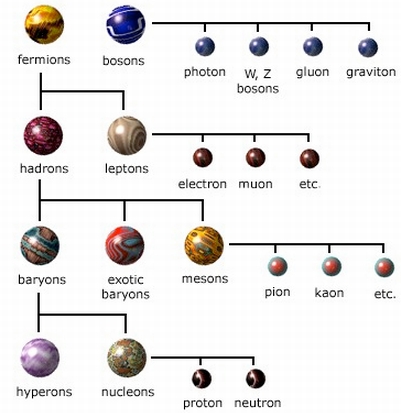So I am all for nice, tidy graphs of that kind. But they need to be correct! If one makes logical errors in their construction they become very deceiving, as the example below shows. I picked it from Facebook, allegedly coming from the page "Cosmology, Relativity, and Quantum Mechanics".
Can you see what is wrong ? Actually, there are several things that I find disturbing, not just one...

First of all, where are the quarks ?! The picture only shows a sample of elementary particles of course -there's literally thousands of known states; and rightly so: we need not discuss each and every one of them to understand the general organization they fit in. However, quarks (there are six of them, all elementary bodies which make up all kinds of hadrons) cannot really be excluded, unless you argue that unlike all displayed particle they are confined inside hadrons. If you did, you would still be wrong, because the top quark, the heaviest of the six, is not confined in hadrons, its decay being too quick to allow the binding into a colourless object.
Can one say that the top should still not belong there because its lifetime is too short ? Not at all, lest you are forced to get rid of the W boson as well (the top quark and the W boson have comparable lifetimes).
So the table is incomplete, and actually there is no easy way to fix it given the format in which it has been laid down. One would have to put quarks below the "fermions" ball, aside the leptons; but then it would be not so easy to understand what those downward bars mean: what relation is it ? Do they mean "the object below is a member of" ? or "is made of" ?
Incidentally: fermions are particles of half-integer spin, in a particular unit of measurement called the "reduced Planck constant"; bosons are particles whose spin is integer, instead. This distinction is quite fundamental, given that the properties of fermions and bosons are totally different ! Indeed, fermions make up matter, while bosons act as messengers of interactions among them.
One further observes that neutrinos are not mentioned either. That might be a justifiable omission, but still the graph would be really incomplete - neutrinos are a very, very important part of the whole picture of elementary particles.
Another minor problem of the attempted classification shown in the graph is the presence of both established and observed particles, and ones only hypothesized (the graviton). In an attempt to not leave out of the picture one of the four fundamental interactions, the graph mixes together known particles with ones only thought to exist.
Also, the Higgs boson is not there. But okay, maybe this graph was drawn before its discovery ? Okay, but then why the graviton ?
And then the thing that bothers me the most: the bars connecting objects in this graph to a "parent" on the same line appear to signify "is an example of", if we look at horizontal ones (photons, W and Z, gluons and gravitons are bosons, e.g.; or electron, muon, tau etc. are leptons). Vertical lines, however, might want to mean something different. Certainly not "these are made of the above", since e.g. while hadrons are made of fermions, leptons are not made of fermions, they _are_ fermions. Could the vertical bars mean "are" ? Well, yes, that appears to be the only explanation. But then the whole picture is seen to be mistaken.
In fact, among hadrons there are baryons and mesons; the former are indeed fermions, and can be rightly traced back to the "fermions" ball by going up the line. But mesons are bosons! The pion, the kaon, etcetera are particles of integer spin, since they are made of a quark-antiquark pair - the two half-integer spins of quarks must combine either as +1/2+1/2=1, or +1/2-1/2=0. So the graph leads you to the fault of believing that mesons are fermions, which is not the case.
So please do not distribute this graph. Its confusion power is very high. Its ideator gets very bad grades - I would say "E" for effort.





Comments